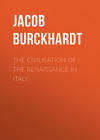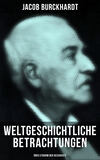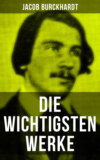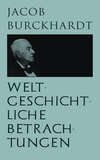Читать книгу: «The Civilisation of the Renaissance in Italy»
PREFACE
DR. Burckhardt’s work on the Renaissance in Italy is too well known, not only to students of the period, but now to a wider circle of readers, for any introduction to be necessary. The increased interest which has of late years, in England, been taken in this and kindred subjects, and the welcome which has been given to the works of other writers upon them, encourage me to hope that in publishing this translation I am meeting a want felt by some who are either unable to read German at all, or to whom an English version will save a good deal of time and trouble.
The translation is made from the third edition of the original, recently published in Germany, with slight additions to the text, and large additions to the notes, by Dr. Ludwig Geiger, of Berlin. It also contains some fresh matter communicated by Dr. Burckhardt to Professor Diego Valbusa of Mantua, the Italian translator of the book. To all three gentlemen my thanks are due for courtesy shown, or help given to me in the course of my work.
In a few cases, where Dr. Geiger’s view differs from that taken by Dr. Burckhardt, I have called attention to the fact by bracketing Dr. Geiger’s opinion and adding his initials.
THE TRANSLATOR.
PART I.
THE STATE AS A WORK OF ART
CHAPTER I.
INTRODUCTION
THIS work bears the title of an essay in the strictest sense of the word. No one is more conscious than the writer with what limited means and strength he has addressed himself to a task so arduous. And even if he could look with greater confidence upon his own researches, he would hardly thereby feel more assured of the approval of competent judges. To each eye, perhaps, the outlines of a given civilisation present a different picture; and in treating of a civilisation which is the mother of our own, and whose influence is still at work among us, it is unavoidable that individual judgment and feeling should tell every moment both on the writer and on the reader. In the wide ocean upon which we venture, the possible ways and directions are many; and the same studies which have served for this work might easily, in other hands, not only receive a wholly different treatment and application, but lead also to essentially different conclusions. Such indeed is the importance of the subject, that it still calls for fresh investigation, and may be studied with advantage from the most varied points of view. Meanwhile we are content if a patient hearing be granted us, and if this book be taken and judged as a whole. It is the most serious difficulty of the history of civilisation that a great intellectual process must be broken up into single, and often into what seem arbitrary categories, in order to be in any way intelligible. It was formerly our intention to fill up the gaps in this book by a special work on the ‘Art of the Renaissance,’—an intention, however, which we have been able only to fulfil1 in part.
The struggle between the Popes and the Hohenstaufen left Italy in a political condition which differed essentially from that of other countries of the West. While in France, Spain and England the feudal system was so organised that, at the close of its existence, it was naturally transformed into a unified monarchy, and while in Germany it helped to maintain, at least outwardly, the unity of the empire, Italy had shaken it off almost entirely. The Emperors of the fourteenth century, even in the most favourable case, were no longer received and respected as feudal lords, but as possible leaders and supporters of powers already in existence; while the Papacy,2 with its creatures and allies, was strong enough to hinder national unity in the future, not strong enough itself to bring about that unity. Between the two lay a multitude of political units—republics and despots—in part of long standing, in part of recent origin, whose existence was founded simply on their power to maintain it.3 In them for the first time we detect the modern political spirit of Europe, surrendered freely to its own instincts, often displaying the worst features of an unbridled egoism, outraging every right, and killing every germ of a healthier culture. But, wherever this vicious tendency is overcome or in any way compensated, a new fact appears in history—the state as the outcome of reflection and calculation, the state as a work of art. This new life displays itself in a hundred forms, both in the republican and in the despotic states, and determines their inward constitution, no less than their foreign policy. We shall limit ourselves to the consideration of the completer and more clearly defined type, which is offered by the despotic states.
The internal condition of the despotically governed states had a memorable counterpart in the Norman Empire of Lower Italy and Sicily, after its transformation by the Emperor Frederick II.4 Bred amid treason and peril in the neighbourhood of the Saracens, Frederick, the first ruler of the modern type who sat upon a throne, had early accustomed himself, both in criticism and action, to a thoroughly objective treatment of affairs. His acquaintance with the internal condition and administration of the Saracenic states was close and intimate; and the mortal struggle in which he was engaged with the Papacy compelled him, no less than his adversaries, to bring into the field all the resources at his command. Frederick’s measures (especially after the year 1231) are aimed at the complete destruction of the feudal state, at the transformation of the people into a multitude destitute of will and of the means of resistance, but profitable in the utmost degree to the exchequer. He centralised, in a manner hitherto unknown in the West, the whole judicial and political administration by establishing the right of appeal from the feudal courts, which he did not, however, abolish, to the imperial judges. No office was henceforth to be filled by popular election, under penalty of the devastation of the offending district and of the enslavement of its inhabitants. Excise duties were introduced; the taxes, based on a comprehensive assessment, and distributed in accordance with Mohammedan usages, were collected by those cruel and vexatious methods without which, it is true, it is impossible to obtain any money from Orientals. Here, in short, we find, not a people, but simply a disciplined multitude of subjects; who were forbidden, for example, to marry out of the country without special permission, and under no circumstances were allowed to study abroad. The University of Naples was the first we know of to restrict the freedom of study, while the East, in these respects at all events, left its youth unfettered. It was after the example of Mohammedan rulers that Frederick traded on his own account in all parts of the Mediterranean, reserving to himself the monopoly of many commodities, and restricting in various ways the commerce of his subjects. The Fatimite Caliphs, with all their esoteric unbelief, were, at least in their earlier history, tolerant of the differences in the religious faith of their people; Frederick, on the other hand, crowned his system of government by a religious inquisition, which will seem the more reprehensible when we remember that in the persons of the heretics he was persecuting the representatives of a free municipal life. Lastly, the internal police, and the kernel of the army for foreign service, was composed of Saracens who had been brought over from Sicily to Nocera and Luceria—men who were deaf to the cry of misery and careless of the ban of the Church. At a later period the subjects, by whom the use of weapons had long been forgotten, were passive witnesses of the fall of Manfred and of the seizure of the government by Charles of Anjou; the latter continued to use the system which he found already at work.
At the side of the centralising Emperor appeared an usurper of the most peculiar kind: his vicar and son-in-law, Ezzelino da Romano. He stands as the representative of no system of government or administration, for all his activity was wasted in struggles for supremacy in the eastern part of Upper Italy; but as a political type he was a figure of no less importance for the future than his imperial protector Frederick. The conquests and usurpations which had hitherto taken place in the Middle Ages rested on real or pretended inheritance and other such claims, or else were effected against unbelievers and excommunicated persons. Here for the first time the attempt was openly made to found a throne by wholesale murder and endless barbarities, by the adoption, in short, of any means with a view to nothing but the end pursued. None of his successors, not even Cæsar Borgia, rivalled the colossal guilt of Ezzelino; but the example once set was not forgotten, and his fall led to no return of justice among the nations, and served as no warning to future transgressors.
It was in vain at such a time that St. Thomas Aquinas, a born subject of Frederick, set up the theory of a constitutional monarchy, in which the prince was to be supported by an upper house named by himself, and a representative body elected by the people; in vain did he concede to the people the right of revolution.5 Such theories found no echo outside the lecture-room, and Frederick and Ezzelino were and remain for Italy the great political phenomena of the thirteenth century. Their personality, already half legendary, forms the most important subject of ‘The Hundred Old Tales,’ whose original composition falls certainly within this century.6 In them Frederick is already represented as possessing the right to do as he pleased with the property of his subjects, and exercises on all, even on criminals, a profound influence by the force of his personality; Ezzelino is spoken of with the awe which all mighty impressions leave behind them. His person became the centre of a whole literature from the chronicle of eyewitnesses to the half-mythical tragedy7 of later poets.
Immediately after the fall of Frederick and Ezzelino, a crowd of tyrants appeared upon the scene. The struggle between Guelph and Ghibelline was their opportunity. They came forward in general as Ghibelline leaders, but at times and under conditions so various that it is impossible not to recognise in the fact a law of supreme and universal necessity. The means which they used were those already familiar in the party struggles of the past—the banishment or destruction of their adversaries and of their adversaries’ households.
CHAPTER II.
THE TYRANNY OF THE FOURTEENTH CENTURY
THE tyrannies, great and small, of the fourteenth century afford constant proof that examples such as these were not thrown away. Their misdeeds cried forth loudly and have been circumstantially told by historians. As states depending for existence on themselves alone, and scientifically organised with a view to this object, they present to us a higher interest than that of mere narrative.
The deliberate adaptation of means to ends, of which no prince out of Italy had at that time a conception, joined to almost absolute power within the limits of the state, produced among the despots both men and modes of life of a peculiar character.8 The chief secret of government in the hands of the prudent ruler lay in leaving the incidence of taxation so far as possible where he found it, or as he had first arranged it. The chief sources of income were: a land tax, based on a valuation; definite taxes on articles of consumption and duties on exported and imported goods; together with the private fortune of the ruling house. The only possible increase was derived from the growth of business and of general prosperity. Loans, such as we find in the free cities, were here unknown; a well-planned confiscation was held a preferable means of raising money, provided only that it left public credit unshaken—an end attained, for example, by the truly Oriental practice of deposing and plundering the director of the finances.9
Out of this income the expenses of the little court, of the body-guard, of the mercenary troops, and of the public buildings were met, as well as of the buffoons and men of talent who belonged to the personal attendants of the prince. The illegitimacy of his rule isolated the tyrant and surrounded him with constant danger; the most honourable alliance which he could form was with intellectual merit, without regard to its origin. The liberality of the northern princes of the thirteenth century was confined to the knights, to the nobility which served and sang. It was otherwise with the Italian despot. With his thirst of fame and his passion for monumental works, it was talent, not birth, which he needed. In the company of the poet and the scholar he felt himself in a new position, almost, indeed, in possession of a new legitimacy.
No prince was more famous in this respect than the ruler of Verona, Can Grande della Scala, who numbered among the illustrious exiles whom he entertained at his court representatives of the whole of Italy.10 The men of letters were not ungrateful. Petrarch, whose visits at the courts of such men have been so severely censured, sketched an ideal picture of a prince of the fourteenth century.11 He demands great things from his patron, the lord of Padua, but in a manner which shows that he holds him capable of them. ‘Thou must not be the master but the father of thy subjects, and must love them as thy children; yea, as members of thy body.12 Weapons, guards, and soldiers thou mayest employ against the enemy—with thy subjects goodwill is sufficient. By citizens, of course, I mean those who love the existing order; for those who daily desire change are rebels and traitors, and against such a stern justice may take its course.’
Here follows, worked out in detail, the purely modern fiction of the omnipotence of the state. The prince is to be independent of his courtiers, but at the same time to govern with simplicity and modesty; he is to take everything into his charge, to maintain and restore churches and public buildings, to keep up the municipal police,13 to drain the marshes, to look after the supply of wine and corn; he is to exercise a strict justice, so to distribute the taxes that the people can recognise their necessity and the regret of the ruler to be compelled to put his hands in the pockets of others; he is to support the sick and the helpless, and to give his protection and society to distinguished scholars, on whom his fame in after ages will depend.
But whatever might be the brighter sides of the system, and the merits of individual rulers, yet the men of the fourteenth century were not without a more or less distinct consciousness of the brief and uncertain tenure of most of these despotisms. Inasmuch as political institutions like these are naturally secure in proportion to the size of the territory in which they exist, the larger principalities were constantly tempted to swallow up the smaller. Whole hecatombs of petty rulers were sacrificed at this time to the Visconti alone. As a result of this outward danger an inward ferment was in ceaseless activity; and the effect of the situation on the character of the ruler was generally of the most sinister kind. Absolute power, with its temptations to luxury and unbridled selfishness, and the perils to which he was exposed from enemies and conspirators, turned him almost inevitably into a tyrant in the worst sense of the word. Well for him if he could trust his nearest relations! But where all was illegitimate, there could be no regular law of inheritance, either with regard to the succession or to the division of the ruler’s property; and consequently the heir, if incompetent or a minor, was liable in the interest of the family itself to be supplanted by an uncle or cousin of more resolute character. The acknowledgment or exclusion of the bastards was a fruitful source of contest; and most of these families in consequence were plagued with a crowd of discontented and vindictive kinsmen. This circumstance gave rise to continual outbreaks of treason and to frightful scenes of domestic bloodshed. Sometimes the pretenders lived abroad in exile, and like the Visconti, who practised the fisherman’s craft on the Lake of Garda,14 viewed the situation with patient indifference. When asked by a messenger of his rival when and how he thought of returning to Milan, he gave the reply, ‘By the same means as those by which I was expelled, but not till his crimes have outweighed my own.’ Sometimes, too, the despot was sacrificed by his relations, with the view of saving the family, to the public conscience which he had too grossly outraged.15 In a few cases the government was in the hands of the whole family, or at least the ruler was bound to take their advice; and here, too, the distribution of property and influence often led to bitter disputes.
The whole of this system excited the deep and persistent hatred of the Florentine writers of that epoch. Even the pomp and display with which the despot was perhaps less anxious to gratify his own vanity than to impress the popular imagination, awakened their keenest sarcasm. Woe to an adventurer if he fell into their hands, like the upstart Doge Aguello of Pisa (1364), who used to ride out with a golden sceptre, and show himself at the window of his house, ‘as relics are shown.’ reclining on embroidered drapery and cushions, served like a pope or emperor, by kneeling attendants.16 More often, however, the old Florentines speak on this subject in a tone of lofty seriousness. Dante saw and characterised well the vulgarity and commonplace which mark the ambition of the new princes.17 ‘What mean their trumpets and their bells, their horns and their flutes; but come, hangman—come, vultures?’ The castle of the tyrant, as pictured by the popular mind, is a lofty and solitary building, full of dungeons and listening-tubes,18 the home of cruelty and misery. Misfortune is foretold to all who enter the service of the despot,19 who even becomes at last himself an object of pity: he must needs be the enemy of all good and honest men; he can trust no one, and can read in the faces of his subjects the expectation of his fall. ‘As despotisms rise, grow, and are consolidated, so grows in their midst the hidden element which must produce their dissolution and ruin.’20 But the deepest ground of dislike has not been stated; Florence was then the scene of the richest development of human individuality, while for the despots no other individuality could be suffered to live and thrive but their own and that of their nearest dependents. The control of the individual was rigorously carried out, even down to the establishment of a system of passports.21
The astrological superstitions and the religious unbelief of many of the tyrants gave, in the minds of their contemporaries, a peculiar colour to this awful and God-forsaken existence. When the last Carrara could no longer defend the walls and gates of the plague-stricken Padua, hemmed in on all sides by the Venetians (1405), the soldiers of the guard heard him cry to the devil ‘to come and kill him.’
The most complete and instructive type of the tyranny of the fourteenth century is to be found unquestionably among the Visconti of Milan, from the death of the Archbishop Giovanni onwards (1354). The family likeness which shows itself between Bernabò and the worst of the Roman Emperors is unmistakable;22 the most important public object was the prince’s boar-hunting; whoever interfered with it was put to death with torture; the terrified people were forced to maintain 5,000 boar-hounds, with strict responsibility for their health and safety. The taxes were extorted by every conceivable sort of compulsion; seven daughters of the prince received a dowry of 100,000 gold florins apiece; and an enormous treasure was collected. On the death of his wife (1384) an order was issued ‘to the subjects’ to share his grief, as once they had shared his joy, and to wear mourning for a year. The coup de main (1385) by which his nephew Giangaleazzo got him into his power—one of those brilliant plots which make the heart of even late historians beat more quickly23—was strikingly characteristic of the man. Giangaleazzo, despised by his relations on account of his religion and his love of science, resolved on vengeance, and, leaving the city under pretext of a pilgrimage, fell upon his unsuspecting uncle, took him prisoner, forced his way back into the city at the head of an armed band, seized on the government, and gave up the palace of Bernabò to general plunder.
In Giangaleazzo that passion for the colossal which was common to most of the despots shows itself on the largest scale. He undertook, at the cost of 300,000 golden florins, the construction of gigantic dykes, to divert in case of need the Mincio from Mantua and the Brenta from Padua, and thus to render these cities defenceless.24 It is not impossible, indeed, that he thought of draining away the lagoons of Venice. He founded that most wonderful of all convents, the Certosa of Pavia,25 and the cathedral of Milan, ‘which exceeds in size and splendour all the churches of Christendom.’ The Palace in Pavia, which his father Galeazzo began and which he himself finished, was probably by far the most magnificent of the princely dwellings of Europe. There he transferred his famous library, and the great collection of relics of the saints, in which he placed a peculiar faith. King Winceslaus made him Duke (1395); he was hoping for nothing less than the Kingdom of Italy26 or the Imperial crown, when (1402) he fell ill and died. His whole territories are said to have paid him in a single year, besides the regular contribution of 1,200,000 gold florins, no less than 800,000 more in extraordinary subsidies. After his death the dominions which he had brought together by every sort of violence fell to pieces; and for a time even the original nucleus could with difficulty be maintained by his successors. What might have become of his sons Giovanni Maria (died 1412) and Filippo Maria (died 1417), had they lived in a different country and among other traditions, cannot be said. But, as heirs of their house, they inherited that monstrous capital of cruelty and cowardice which had been accumulated from generation to generation.
Giovanni Maria, too, is famed for his dogs, which were no longer, however, used for hunting, but for tearing human bodies. Tradition has preserved their names, like those of the bears of the Emperor Valentinian I.27 In May, 1409, when war was going on, and the starving populace cried to him in the streets, Pace! Pace! he let loose his mercenaries upon them, and 200 lives were sacrificed; under penalty of the gallows it was forbidden to utter the words pace and guerra, and the priests were ordered, instead of dona nobis pacem, to say tranquillitatem! At last a band of conspirators took advantage of the moment when Facino Cane, the chief Condottiere of the insane ruler, lay ill at Pavia, and cut down Giovan Maria in the church of San Gottardo at Milan; the dying Facino on the same day made his officers swear to stand by the heir Filippo Maria, whom he himself urged his wife28 to take for a second husband. His wife, Beatrice di Tenda, followed his advice. We shall have occasion to speak of Filippo Maria later on.
And in times like these Cola di Rienzi was dreaming of founding on the rickety enthusiasm of the corrupt population of Rome a new state which was to comprise all Italy. By the side of rulers such as those whom we have described, he seems no better than a poor deluded fool.
So Corio, fol. 286, and Poggio, Hist. Florent. iv. in Murat. xx. col 290.—Cagnola (loc. cit.) speaks of his designs on the imperial crown. See too the sonnet in Trucchi, Poesie Ital. ined., ii. p. 118:
“Stan le città lombarde con le chiaveIn man per darle a voi … etc.Roma vi chiamo: Cesar mio novelloIo sono ignuda, e l’anima pur vive:Or mi coprite col vostro mantello,” etc.
[Закрыть]
Покупайте книги и получайте бонусы в Литрес, Читай-городе и Буквоеде.
Участвовать в бонусной программе



















